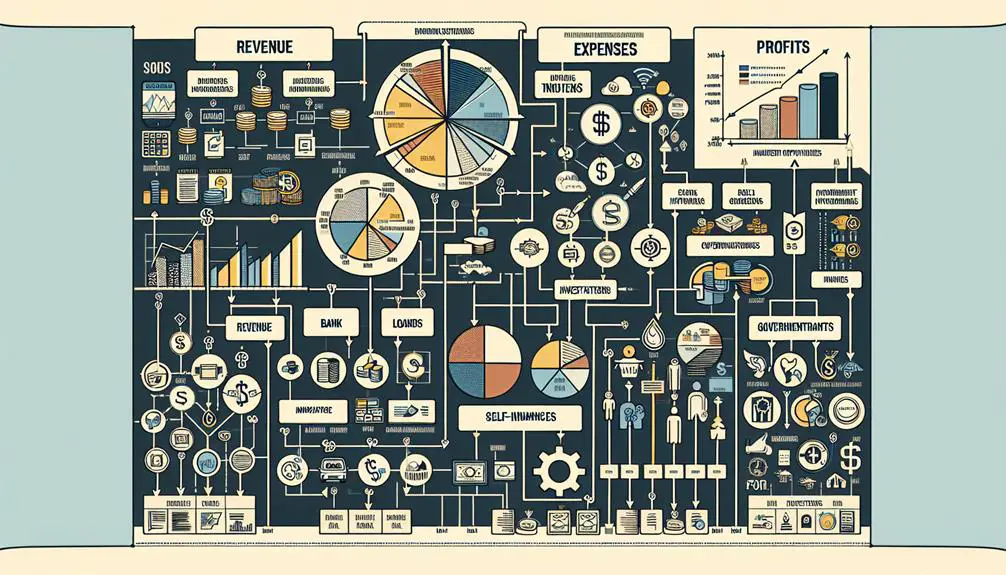Crafting a comprehensive and cohesive financial plan for your small business is a critical cornerstone of success. As a business owner, I’ve come to realize the paramount importance of laying a solid financial foundation.
It’s not just about numbers; it’s about nurturing the growth and sustainability of your venture. The journey to financial security for your business begins with careful consideration and strategic decision-making, and I’ve found that there are many facets to explore and consider when embarking on this path.
Let’s explore the key elements that can help fortify your small business against financial uncertainties and pave the way for long-term success.
Key Takeaways
- Financial planning is crucial for effective resource allocation and decision-making in a small business.
- A comprehensive financial plan includes components such as income statement, balance sheet, cash flow projection, and personnel plan.
- Revenue projections and cost management are essential for accurate financial planning and maximizing profitability.
- Leveraging financial management software can improve efficiency, accuracy, and decision-making in financial management.
Understanding Financial Planning
Understanding financial planning is crucial for effective resource allocation and decision-making. As a small business owner, I’ve realized that having a clear financial plan is essential for steering my company in the right direction. It’s not just about numbers; it’s about understanding the financial landscape and using that knowledge to drive innovation and growth.
A financial plan serves as a roadmap, outlining our goals and the strategies we’ll use to achieve them. It helps us anticipate potential risks, secure funding, and track our performance. By delving into the components of a financial plan such as the income statement, balance sheet, cash flow projection, and personnel plan, I’ve been able to gain a deeper understanding of my business’s financial health.
Moreover, sound financial planning provides a framework for making critical business decisions, setting achievable goals, and adapting to the ever-changing economy. It’s not just about meeting financial obligations; it’s about leveraging our finances to drive innovation and propel our small business forward.
Understanding financial planning isn’t just a necessity; it’s a catalyst for innovation and success.
Importance of Financial Planning

Realizing the critical role financial planning plays in steering a small business toward success, I’m now prepared to highlight the significance of this practice in ensuring long-term stability and growth.
Financial planning isn’t just about managing expenses and revenue; it’s about strategically allocating resources to drive innovation and propel the business forward. By carefully assessing the financial landscape, businesses can determine if they’ve sufficient capital for expansion and investment, or if reserve funds should be leveraged to seize growth opportunities.
Moreover, a comprehensive financial plan showcases a company’s commitment to sound business practices, which is crucial for building trust with stakeholders and attracting potential investors. Neglecting financial planning can lead to missed opportunities, hindered growth, and increased financial risk.
Many companies overlook this process, often due to intimidation or simply not prioritizing it. However, in today’s rapidly evolving business environment, financial planning isn’t just important; it’s essential for establishing a strong foundation and achieving long-term success.
Key Components of a Financial Plan

When developing a financial plan for a small business, it’s crucial to focus on key components such as revenue projections and cost management.
These elements form the foundation of a solid financial strategy, as they directly impact the business’s profitability and sustainability.
Revenue Projections
To create accurate revenue projections in a financial plan, it is essential to thoroughly analyze sales forecasts and consider potential cost increases and cash flow assumptions. By incorporating innovative strategies and leveraging market trends, a small business can develop robust revenue projections. Here’s a breakdown of a quarterly revenue projection table for the first two years:
| Year/Quarter | Quarter 1 | Quarter 2 | Quarter 3 |
|---|---|---|---|
| Year 1 | $XXX | $XXX | $XXX |
| Year 2 | $XXX | $XXX | $XXX |
This approach allows for a dynamic assessment of revenue growth and helps in anticipating potential challenges. By integrating these projections with detailed cash flow and balance sheet breakdowns, a business can ensure its financial plan is comprehensive and forward-thinking.
Cost Management
Cost management is a critical aspect of a comprehensive financial plan for small businesses. It enables efficient allocation of resources and maximizing profitability. By implementing cost management strategies, businesses can control expenses and identify various cost components such as fixed, variable, and semi-variable expenses.
It’s essential to regularly review and adjust the budget to ensure optimal resource allocation. Consider adopting cost-saving measures like bulk purchasing, negotiating with suppliers, and streamlining processes to minimize expenses. Utilizing cost management tools and software can also aid in effectively tracking and managing expenses.
Embracing innovative cost management practices not only ensures financial stability but also provides the opportunity to reallocate resources towards growth and development initiatives.
Steps to Create a Financial Plan

I recommend that we start by creating a strategic plan for the financial future of our small business. This will provide a roadmap for achieving our financial goals and ensure that our resources are allocated effectively.
To create a solid financial plan, we should consider the following steps:
- Creating financial projections: Utilize data and market trends to forecast future financial performance. This will help us make informed decisions and set realistic targets.
- Planning for contingencies: Anticipate potential financial challenges and develop strategies to mitigate risks. By being prepared for unexpected events, we can protect our business from potential setbacks.
- Improving financial planning with software: Embrace innovative financial planning tools and software to streamline processes and gain valuable insights. Leveraging technology can enhance our decision-making and optimize our financial management.
Questions Your Financial Plan Should Answer

As a small business owner, understanding the specific questions your financial plan should address is crucial for the success and sustainability of your venture. Your financial plan should be able to answer the following key questions:
| Key Questions |
|---|
| What are the capital requirements for the business? |
| How will the revenue be utilized? |
| What are the future earnings projections and financial breakdown? |
| How will the venture be financed? |
| How will the financial plan adapt to changing conditions over time? |
Answering these questions is essential for creating a solid financial plan that can adapt to the dynamic nature of business. By addressing the capital requirements, revenue allocation, earnings projections, financing strategies, and adaptability to changing conditions, your financial plan will provide a clear roadmap for the financial success of your small business. Embracing innovation in financial planning will not only ensure the stability of your business but also position it for growth and resilience in the face of evolving market trends.
Leveraging Financial Management Software

Streamlining financial processes and improving efficiency can be achieved by leveraging financial management software. This innovative tool offers a range of benefits for small businesses, including:
- Real-time Tracking and Management: Financial management software can help track and manage income, expenses, and cash flow in real-time, providing a clear and up-to-date overview of the business’s financial health.
- Automation of Tasks: By utilizing financial management software, tasks such as invoicing, payroll, and budgeting can be automated, saving time and reducing the risk of errors. This allows the business to focus on strategic activities while routine financial tasks are efficiently handled by the software.
- Enhanced Financial Transparency and Compliance: Leveraging financial management software can enhance financial transparency and ensure compliance with regulations. The software can provide accurate and timely financial reports, enabling informed decision-making and demonstrating a commitment to financial integrity.
Incorporating financial management software into the business’s operations can lead to increased productivity, improved accuracy, and better financial control, ultimately contributing to the overall success of the small business.
FAQs on Small Business Financial Planning

I’ll begin by addressing some common questions about small business financial planning.
We’ll cover key financial metrics, budgeting and forecasting, and risk management.
These are essential aspects of financial planning that can greatly impact the success of a small business.
Key Financial Metrics
Tracking key financial metrics is essential for small businesses to effectively monitor and evaluate their financial performance. By analyzing these metrics, businesses can make informed decisions and drive growth and profitability.
Some key financial metrics to track include:
- Revenue Growth Rate: This metric indicates the rate at which a company’s sales are increasing, providing insight into its overall business performance.
- Profit Margin: By measuring the percentage of each sale that translates into profit, businesses can assess their operational efficiency and pricing strategies.
- Cash Flow Coverage Ratio: This ratio helps assess a company’s ability to meet its financial obligations, providing crucial insights into its financial health and stability.
Tracking these metrics not only aids in assessing current performance but also enables proactive strategic planning to foster innovation and sustainable business development.
Budgeting and Forecasting
Budgeting and forecasting play a crucial role in the financial planning of small businesses, providing a roadmap for allocating resources and anticipating future financial performance. By creating a budget, I can set clear financial goals and allocate resources effectively, while forecasting allows me to anticipate potential financial scenarios and make proactive decisions. Here’s a comparison table to illustrate the key differences between budgeting and forecasting:
| Budgeting | Forecasting |
|---|---|
| Focuses on setting financial goals and allocating resources | Focuses on predicting future financial performance and potential scenarios |
| Typically covers a shorter time frame, such as a year | Looks further into the future, often covering multiple years |
| Involves detailed planning and allocation of funds | Relies on assumptions and predictive models to anticipate financial outcomes |
| Provides a basis for monitoring and controlling expenses | Helps in identifying potential financial risks and opportunities |
This approach aligns with the innovative mindset that seeks to leverage data-driven insights for strategic decision-making.
Risk Management
When it comes to small business financial planning, understanding and managing risks is essential for ensuring long-term success and stability. As a small business owner, it’s crucial to proactively identify and address potential risks to protect your business and its financial health.
Here are key strategies for effective risk management:
- Implementing a comprehensive insurance plan to cover various potential risks such as property damage, liability, and business interruption.
- Diversifying your investments and revenue streams to spread risk and reduce vulnerability to market fluctuations.
- Developing contingency plans for potential risks, such as economic downturns or supply chain disruptions, to maintain operational resilience.
Tips for Effective Financial Planning

To effectively plan your finances for a small business, it’s crucial to set clear financial goals and objectives. By defining specific targets, such as revenue milestones or expense reduction goals, you can create a roadmap for your business’s financial success.
Additionally, creating a detailed budget to track income and expenses is essential. This allows you to identify areas where costs can be minimized and revenue can be maximized.
Monitoring cash flow regularly is also vital to ensure the business stays solvent. By understanding the ebb and flow of cash within your business, you can make informed decisions to support ongoing operations and growth.
Furthermore, planning for contingencies and unexpected expenses is a proactive approach to mitigating financial risks. It’s important to anticipate and prepare for unforeseen circumstances that could impact your business’s financial stability.
Lastly, seeking expert guidance and advice can provide valuable insights and strategies to optimize your financial plan, leveraging their expertise to drive innovation and growth in your small business.
Conclusion
In conclusion, creating a solid financial plan for your small business is like building a sturdy bridge to success.
By understanding the terrain, laying strong foundations, and regularly maintaining it, you can ensure a smooth journey to your business goals.
Don’t forget to leverage technology and stay flexible in your approach.
With a well-crafted financial plan, you’ll be better equipped to navigate the financial landscape and steer your business towards prosperity.


